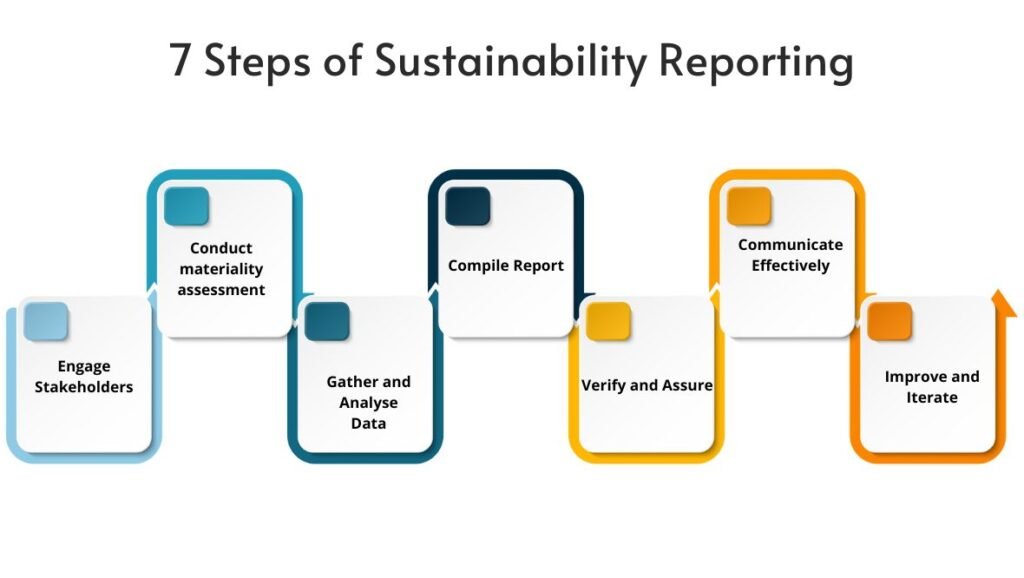7 Essential Steps of Sustainability Reporting

Find out what the sustainability reporting process looks like in action, broken down and explained in seven essential steps.
A sustainability reporting project moves through various phases from start to finish. This article will provide you with a comprehensive breakdown of all these steps. From engaging stakeholders, assessing materiality, and collecting data to analyzing results and communicating impact, we’ll explore each stage of the reporting process. Whether you’re new to sustainability reporting or seeking to enhance your existing practices, this article will equip you with the knowledge and tools necessary for implementing a practical and effective sustainability reporting project.

1. Engage Stakeholders
While stakeholder engagement is a broader practice across time and scale, it is performed in a more targeted capacity as the first step to sustainability reporting. Some key characteristics of the practical implementation of stakeholder engagement for sustainability reporting are:
- It forms the basis for materiality assessment (more on this in step 2)
- At a minimum level it includes performing a stakeholder survey, preferably also some interviews, and if budget allows, then focus groups.
- Collecting previous stakeholder engagement data from customer feedback, customer satisfaction surveys, inquiries, supplier feedback, job satisfaction surveys, etc.
2. Conduct materiality assessment
Conducting a materiality assessment involves a strategic and practical approach to identifying the most significant environmental, social, and governance (ESG) issues that require attention and disclosure.
- Begin by gathering relevant data through internal and external sources. This includes reviewing industry standards, regulations, and stakeholder expectations. Collaborate with key departments within your organization to gain insights into various operational impacts. Engage with stakeholders through surveys, interviews, and consultations to understand their concerns and priorities.
- Once you’ve collected ample data, evaluate the potential impacts of these issues. Double materiality warrants considering both the direct effects on your organization’s operations and the wider societal implications. Rank the issues based on their significance and relevance to your business and stakeholders. This ranking will guide your reporting focus.
- To ensure practical implementation, integrate the identified material issues into your sustainability strategy and business operations. Set specific targets and key performance indicators (KPIs) related to these issues. Regularly track and report progress against these targets, showcasing how your organization is addressing its material concerns.

3. Gather and Analyse Data
Gathering and analyzing data for sustainability reporting is key to producing an accurate and authentic report that showcases your organization’s commitment to transparency and responsible practices. This step involves a structured approach that ensures the information presented is not only comprehensive but also credible.
- Begin by identifying the key performance indicators (KPIs) relevant to your industry and operations within the reporting scope as defined by materiality assessment. These indicators could range from energy consumption and carbon emissions to employee well-being and community engagement. Clearly define the data points needed to calculate these indicators.
- Collecting data from various sources, both internal and external, is crucial. Your organization’s departments, such as operations, finance, and HR, can provide valuable insights. Additionally, external benchmarks and industry standards provide context for your performance. Invest in data management systems that streamline the process, ensuring accuracy and consistency.
- Once gathered, rigorously analyze the data. Look for trends, patterns, and deviations. Identify areas where you’ve excelled and those needing improvement. This analysis provides the foundation for setting goals and strategies for the coming reporting period.
4. Compile Report
Compiling a sustainability report involves structuring your gathered data and insights into a coherent and engaging narrative that satisfies:
- Relevant compliance requirements
- Requirements of the chosen sustainability reporting standard
- Is in line with the scope of reporting as defined by the materiality assessment and
- Stays true to stakeholder expectations
- A credible sustainability report always covers all the three fields: Environmental, Social and Governance, even if they are divided into smaller categories or named differently.
- Choose a clear framework for your report that aligns with global reporting standards like GRI (Global Reporting Initiative) or SASB (Sustainability Accounting Standards Board). This ensures consistency and comparability across reports.
- Organize your report to tell a compelling story. Begin with an executive summary that highlights your achievements, challenges, and future goals. Use concise language and visuals to break down complex data and concepts for easier understanding.
- When compiling the report, focus on authenticity and balance. Acknowledge both successes and areas where improvement is needed. Incorporate case studies and real-life examples to illustrate the impact of your initiatives. This adds a human element that resonates with readers. Utilize infographics and charts to simplify complex data points.

5. Verify and Assure
Verifying and assuring your sustainability report is a critical step to ensure the credibility and reliability of your disclosed information. This can be done internally and externally.
- Internal: Conduct thorough reviews to validate data accuracy and adherence to reporting standards. Set up an in-house auditing personnel or team with the required skillset and knowledge that will collaborate with the sustainability reporting team to double check and verify the contents of the report.
- External: Engage independent sustainability experts to audit the report and provide external assurance. Respond to audit feedback by making recommended changes. External validation enhances trust in the report’s transparency and accuracy.
6. Communicate Effectively
Providing relevant information to all stakeholders in an accessible easy to easy-to-understand format is one of the main functions of a sustainability report. This makes the effective communication of the report a fundamental step.
- Practically implementing this step involves tailoring your message, selecting appropriate channels, and fostering engagement. Select communication channels that align with your target audience. Utilize your website, social media, and email newsletters to reach a broader online audience. Consider in-person events, webinars, and workshops for more personalized interactions.
- Encourage two-way communication. Invite stakeholders to provide feedback, ask questions, and engage in discussions. Respond promptly and transparently to inquiries, showcasing your commitment to open dialogue.
- Effective communication doesn’t stop with publishing the report. Continue the conversation by sharing insights, initiatives, and success stories throughout the year. By doing so, you foster a sense of shared responsibility and maintain a strong connection with stakeholders, ensuring your sustainability efforts stay firmly in the spotlight.

7. Improve and Iterate
Improving and iterating your sustainability reporting process is a dynamic and crucial step to ensure continuous growth and relevance. It involves assessing your reporting practices, seeking feedback, and adapting to changing circumstances.
- Start by conducting a comprehensive review of your reporting process. Analyze what worked well and what needs enhancement. Consider internal reflections as well as input from stakeholders, auditors, and industry peers.
- Feedback is a valuable asset. Engage with stakeholders to understand their perception of your reports and areas that need improvement. Use surveys, focus groups, and direct communication to gather insights.
- Based on feedback, make necessary adjustments to your reporting framework. This could involve refining the data collection process, enhancing communication strategies, or adding new KPIs to address emerging concerns.
- Adaptation is key in the ever-evolving sustainability landscape. Stay updated with evolving reporting standards and industry trends. Implement changes that align with new expectations and regulations.
- Regularly review your sustainability goals and targets. Are they still relevant and ambitious? Adjust them to reflect changes in your business landscape and societal needs.
Remember, improvement is an ongoing journey. Continuously iterate your reporting process, integrating feedback, and staying attuned to the changing sustainability landscape. By embracing a culture of constant improvement, you ensure that your reports remain insightful, accurate, and impactful, contributing to your organization’s sustainable growth.


